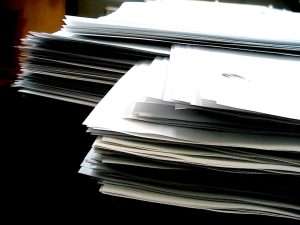Whether you finished up your homeschool year last week or last month, if you’re anything like me, you probably still have some end of the year organization to do.
- Go through your house and gather all the homeschool materials you used this year.
- Divide materials into
- Reusable texts
- Consumables (eg workbooks)
- Papers/projects
- School supplies
- Store as outlined below
Organizing Reusable Textbooks and other books
This first step in organizing textbooks and other books that you have used but are still able to be used by another student is determining if you would reuse it in your home. Ask yourself these questions.
Did we enjoy this book?
Do I have younger children who would enjoy or need this book in the future?

If you answered yes to those questions, then you should probably keep the book. I have found that the best way to store books, not surprisingly, is on bookshelves. Generally, I try to arrange our homeschool bookshelves by subject. I don’t have all our homeschool bookshelves in the same room though that would be ideal if space permits. Don’t overthink bookshelf arrangement too much at this point. You just need to collect all the texts and other books that you are keeping for later years for shelving.
What about those books that you don’t want to keep? Those books should be either sold or donated as soon as possible. Don’t put them in a to sell stack and leave them there for months on end. (Hypothetically, of course.) If selling, you can try Ebay, your local homeschool group, Facebook marketplace, HomeschoolUsedBook.com, or a used bookstore. Your local library or thrift shop will probably take book donations.
Organizing Consumable Workbooks
Next up is the consumable workbook stack.
Is this fully used?
If not, are we planning to finish this?
A fully used workbook can probably throw into the trash or recycle. If you live in a state that requires portfolios or someone to look over your student’s work, then that may not be the case. You should determine what completed work needs to be kept. Even if you don’t live in a state where you are required to show work, you may choose to rip out a page or two to keep as a sample. Or instead of ripping out physical pages, you could scan them.
If the workbook is not completed and you plan to complete it next year, then it needs to be placed with your curriculum for the next year. If it’s not completed and you don’t intend on finishing it, then you are allowed to throw away or recycle as above. Don’t hold onto partially completed workbooks that weren’t a good fit for your kids. They only induce guilt.
Organizing Homeschool Papers and Projects

Papers and projects are a bit trickier to determine what to keep. Some of this is going to depend on your personal clutter preference levels. Unless you need them for a portfolio, you can probably dispose of these. However, I do think it’s nice to hold on to some work samples and favorite assignments from each year. I guess you could call me a sentimental minimalist.
One suggestion I have seen to help contain and limit the clutter is to create a single memory box per child with hanging folders for each year. You can only save what can fit in the box. I have a banker’s box for each child. Projects should be photographed and then discarded. Exceptions can be made for special projects. We held on to our Tabernacle Model for many years. I have to confess that I have some very old history and science binders that have been stored out of the way for way too long. They aren’t taking up prime shelf real estate so I haven’t made purging them a priority.
Organizing School Supplies

I am an admitted school supply hoarder. The back-to-school sales always get me. So gather up all your used school supplies and see what you can still use next year. Then check your stash of school supplies and see what you already have so that you can avoid overbuying. I am making a school supply list that includes what we do NOT need. (Spiral notebooks, pocket folders, and crayons). If you have more new crayons than you can possibly use, consider donating some of your extra boxes. I’ve put boxes of new crayons into Operation Christmas child boxes. And for a fun craft with those broken crayons you can recycle them by making new crayons.
Hopefully this gives you a little push to tackle this homeschool organization task and maybe some new ideas about what to do with everything you’ve collected. I know I’m feeling inspired to tackle my own mess!
